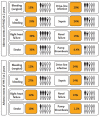Update on heart failure management and future directions
- PMID: 30612416
- PMCID: PMC6325445
- DOI: 10.3904/kjim.2018.428
Update on heart failure management and future directions
Erratum in
-
Update on heart failure management and future directions.Korean J Intern Med. 2019 Jul;34(4):944. doi: 10.3904/kjim.2018.428.e1. Epub 2019 Jul 1. Korean J Intern Med. 2019. PMID: 31272145 Free PMC article. No abstract available.
Abstract
Heart failure (HF) is an important cardiovascular disease because of its increasing prevalence, significant morbidity, high mortality, and rapidly expanding health care cost. The number of HF patients is increasing worldwide, and Korea is no exception. There have been marked advances in definition, diagnostic modalities, and treatment of HF over the past four decades. There is continuing effort to improve risk stratification of HF using biomarkers, imaging and genetic testing. Newly developed medications and devices for HF have been widely adopted in clinical practice. Furthermore, definitive treatment for end-stage heart failure including left ventricular assist device and heart transplantation are rapidly evolving as well. This review summarizes the current state-of-the-art management for HF and the emerging diagnostic and therapeutic modalities to improve the outcome of HF patients.
Keywords: Diagnosis; Heart failure; Management; Prognosis.
Conflict of interest statement
No potential conflict of interest relevant to this article was reported.
Figures






References
-
- Ponikowski P, Voors AA, Anker SD, et al. 2016 ESC guidelines for the diagnosis and treatment of acute and chronic heart failure: the task force for the diagnosis and treatment of acute and chronic heart failure of the European Society of Cardiology (ESC) developed with the special contribution of the Heart Failure Association (HFA) of the ESC. Eur Heart J. 2016;37:2129–2200. - PubMed
Publication types
MeSH terms
Substances
Grants and funding
LinkOut - more resources
Full Text Sources
Medical
Research Materials
Miscellaneous
